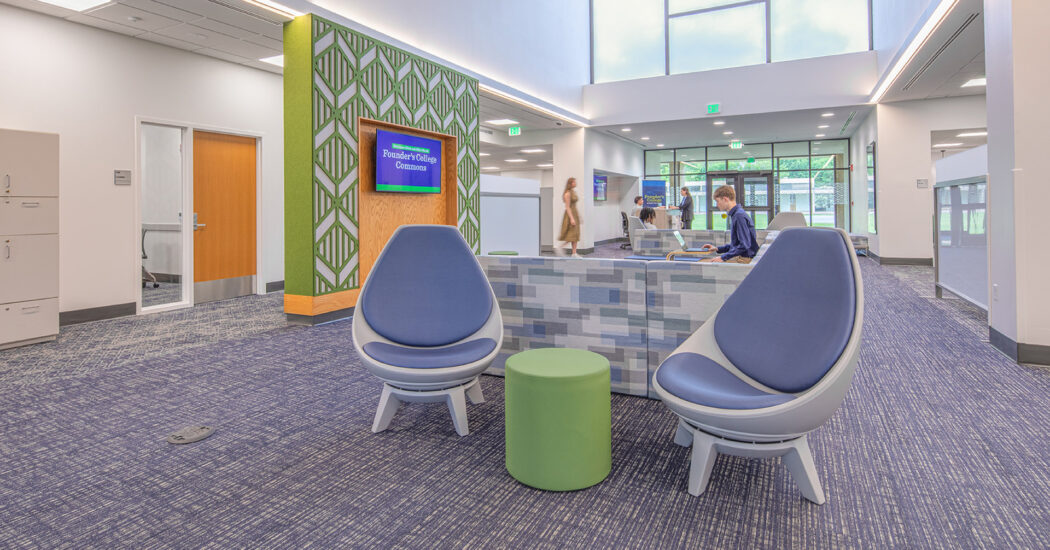Deferred Maintenance and Master Planning
-
Category
Achievements, Studio-Higher Ed -
Posted By
Sarah Hempstead -
Posted On
Feb 18, 2022
Across the country, facilities staff, advancement officers, and CFOs alike are tackling deferred maintenance and master planning to ensure safety, reliability, and efficiency. Those responsible recognize how daunting this is, especially with tighter budgets, less state funding, and project backlogs.
“When deferred maintenance is addressed early and often with an understanding of which priorities to tackle and in what order, Owners can save a lot by consolidating when repair costs and time outweigh budgets,” says Lisa Gomperts, principal and higher education studio project manager at Schmidt Associates.
With years of experience working with multiple private and public colleges and universities, Gomperts guides clients. In November 2021, she and others from the firm hosted a roundtable discussion for chief financial officers during the Independent Colleges of Indiana Fall CFO Meeting where four key questions about conducting assessments and developing master plans were discussed. Here are the top questions and answers.
4 Key Questions for Colleges to Consider
1. What are the risks with limited understanding of how master plans and assessments coincide?
Facility campus master plans create a roadmap for capital projects to support more significant strategic initiatives, and ideally, updated every three to five years. While master planning is necessary, the exercise is not free of challenges, so aligning your plan with overarching campus initiatives is crucial. Identify a starting point, understand cost implications and metrics, prioritize, and finally, build financial support. Facility condition assessments address deferred maintenance needs, existing building conditions, scope, and cost, and usually take three to six months to complete, depending upon the amount of review and feedback the Owner provides.

Often, we find that master plans and facility condition assessments run independently of each other. When possible, it is recommended to work on them simultaneously to save time and money. If a master plan is under development or refreshed, consider your facility condition assessment to avoid unnecessary building and teardown.
2. Why hire an outside consultant for a facility assessment?
Having fresh eyes from an outside perspective is always helpful to holistically assess campus buildings and facilities. Outside professionals let you focus on overseeing your buildings, design, construction, and facilities. Additionally, full-service firms with a team of architects and engineers to walk through buildings and evaluate each piece of equipment can eliminate disparate information and allow you to hear from seasoned professionals with institutional knowledge about equipment and facilities. During a facility assessment, buildings should be considered based on site, building shell, interior finishes, and building systems such as plumbing, HVAC and electrical, and technology.

3. How should a facility assessment be initiated and updated?
This is not a one-size, fits all answer as different building types will have varying needs. As a facility owner, it’s vital to understand your goals with a facility assessment and work with your professional partners to align those goals with the scope of the assessment. We advocate asking questions and utilizing professionals who will guide you if you don’t know what to ask.
For example, do all facilities need to be assessed at once or is there a priority grouping of buildings needing a review? What type of information will be most helpful to include? Do only current conditions of the building systems need updating, or is it also worthwhile to evaluate ADA-accessibility and alignment with current code standards? What about incorporating upgraded technology for consistency across all facilities while exploring system redundancies with generators and utility infrastructure? It’s also important to know the level of detail desired in the assessment, whether that’s a high-level overview or a detailed work list that can be updated regularly to help define deliverables that will be necessary for years to come.
4. Beyond campus facility managers, advancement staff, and CFOs, who else should be involved in campus assessments and master planning?
Building improvement projects are part of more significant strategic initiatives tied to a university’s mission and vision. That’s why we always recommend gathering input from the institution’s leadership team, board members, community leaders, students, parents, and others to develop a clearly defined roadmap to use when working to meet the goals and objectives necessary to create master plans.

Even in the best times, campus facility upkeep can be expensive, and master planning can be tedious. But, with proper planning and determining needs early, you can make your campus buildings operate safely, efficiently, and with greater savings in time and expense long-term. This alone is worth the challenge.
Takeaway: Have a Plan
“The biggest takeaway is don’t delay and have a plan,” says Gomperts. “With so many competing needs for institutional dollars, it’s critical to get buy-in for facilities funding. Therefore, communicating your case to senior administration is essential, so work with someone who can share numbers in digestible form.”







